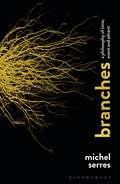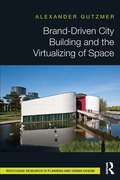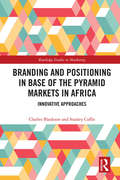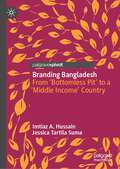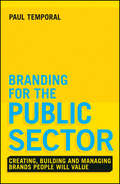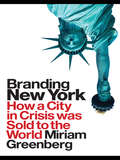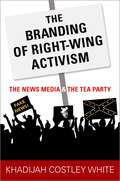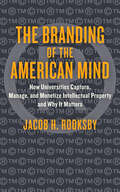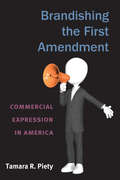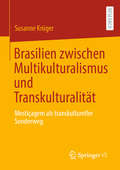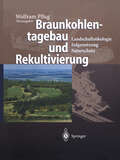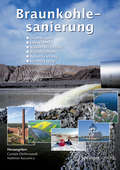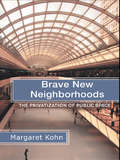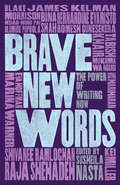- Table View
- List View
Branches: A Philosophy of Time, Event and Advent
by Michel SerresDespite being one of France's most enduring and popular philosophers, Branches is the first English translation of what has been identified as Michel Serres' key text on humanism. In attempting to reconcile humanity and nature, Serres examines how human history 'branches' off from its origin story. Using the metaphor of a branch springing from the stem and arguing that the branch's originality derives its format, Serres identifies dogmatic philosophy as the stem, while philosophy as the branch represents its inventive, shape-shifting, or interdisciplinary elements. In Branches, Serres provides a unique reading of the history of thought and removes the barriers between science, culture, art and religion. His fluency and this fluidity of subject matter combine here to make a book suitable for students of Continental philosophy, post-humanism, the medical humanities and philosophical science, while providing any reader with a wider understanding of the world in which they find themselves.
Branches: A Philosophy of Time, Event and Advent
by Michel SerresDespite being one of France's most enduring and popular philosophers, Branches is the first English translation of what has been identified as Michel Serres' key text on humanism. In attempting to reconcile humanity and nature, Serres examines how human history 'branches' off from its origin story. Using the metaphor of a branch springing from the stem and arguing that the branch's originality derives its format, Serres identifies dogmatic philosophy as the stem, while philosophy as the branch represents its inventive, shape-shifting, or interdisciplinary elements. In Branches, Serres provides a unique reading of the history of thought and removes the barriers between science, culture, art and religion. His fluency and this fluidity of subject matter combine here to make a book suitable for students of Continental philosophy, post-humanism, the medical humanities and philosophical science, while providing any reader with a wider understanding of the world in which they find themselves.
Brand-Driven City Building and the Virtualizing of Space
by Alexander GutzmerThis book is an investigation of the cultural phenomenon of branding and its transformational effects on the contemporary spatial – and urban – reality. It develops a novel understanding of the rationale behind the construction of large-scale architectural complexes that relate to corporate brands, and of its tremendous cultural effects. The author suggests that what we see today is the creation of "global mass ornaments", of a thorough ornamentalization of the entire globe. The origins of this are discussed with regard to examples of corporate brand-building from Europe and China (Autostadt Wolfsburg, BMW Welt Munich and Anting New Town). Additional cases are several simulated spaces in Berlin and the space-branding activities of companies like Apple or Prada. Theoretically, the author develops an innovative poststructuralist framework, combining ideas from Gilles Deleuze with the space philosophy of Peter Sloterdijk. He analyzes how the corporate redefinition of space makes the city enter into a mode of virtual urbanity. This idea leads to a notion of a "global urban" and, ultimately, the "global mass ornament". This concept of a global mass ornament is developed here with reference to Sloterdijk’s concept of a world of "spheres". The latter is used to understand the new mode of spatiality of mediatized spaces. The book makes the point that our world is involved in a process of mass ornamentalization that has only just begun. The concept of the global mass ornament is the first to come to grips with a culture in which branding is effectively changing the physiognomy of the earth. The global mass ornament is a banner for a cultural transformation that employs architecture, sign theory and mechanisms borrowed from traditional advertising and from social media, as well as social processes – and that we have yet to properly understand. This book is a significant step forward in this respect.
Brand-Driven City Building and the Virtualizing of Space
by Alexander GutzmerThis book is an investigation of the cultural phenomenon of branding and its transformational effects on the contemporary spatial – and urban – reality. It develops a novel understanding of the rationale behind the construction of large-scale architectural complexes that relate to corporate brands, and of its tremendous cultural effects. The author suggests that what we see today is the creation of "global mass ornaments", of a thorough ornamentalization of the entire globe. The origins of this are discussed with regard to examples of corporate brand-building from Europe and China (Autostadt Wolfsburg, BMW Welt Munich and Anting New Town). Additional cases are several simulated spaces in Berlin and the space-branding activities of companies like Apple or Prada. Theoretically, the author develops an innovative poststructuralist framework, combining ideas from Gilles Deleuze with the space philosophy of Peter Sloterdijk. He analyzes how the corporate redefinition of space makes the city enter into a mode of virtual urbanity. This idea leads to a notion of a "global urban" and, ultimately, the "global mass ornament". This concept of a global mass ornament is developed here with reference to Sloterdijk’s concept of a world of "spheres". The latter is used to understand the new mode of spatiality of mediatized spaces. The book makes the point that our world is involved in a process of mass ornamentalization that has only just begun. The concept of the global mass ornament is the first to come to grips with a culture in which branding is effectively changing the physiognomy of the earth. The global mass ornament is a banner for a cultural transformation that employs architecture, sign theory and mechanisms borrowed from traditional advertising and from social media, as well as social processes – and that we have yet to properly understand. This book is a significant step forward in this respect.
Branding and Positioning in Base of the Pyramid Markets in Africa: Innovative Approaches (Routledge Studies in Marketing)
by Charles Blankson Stanley CoffieBrand management to sustain corporate reputation and customer loyalty is essential for both multinationals and indigenous fi rms in Africa. This book provides a practical overview of country branding and positioning activities in Africa, based on a broad defi nition of base of the pyramid (BoP) marketing, which includes both goods and services, as well as business-to-business marketing, corporate branding, and country branding. The text highlights branding strategies that can be adopted in BoP markets, as well as marketing mix strategies appropriate for much of the continent. Taking into account the role of social networks, culture, and religion, the book explores avenues for developing and building competitive advantage, and how African countries can leverage country branding as part of the development process. The book is ideal for researchers, educators and advanced students in international marketing, management, and brand strategy who are interested in the unique branding characteristics of the African continent.
Branding and Positioning in Base of the Pyramid Markets in Africa: Innovative Approaches (Routledge Studies in Marketing)
by Charles Blankson Stanley CoffieBrand management to sustain corporate reputation and customer loyalty is essential for both multinationals and indigenous fi rms in Africa. This book provides a practical overview of country branding and positioning activities in Africa, based on a broad defi nition of base of the pyramid (BoP) marketing, which includes both goods and services, as well as business-to-business marketing, corporate branding, and country branding. The text highlights branding strategies that can be adopted in BoP markets, as well as marketing mix strategies appropriate for much of the continent. Taking into account the role of social networks, culture, and religion, the book explores avenues for developing and building competitive advantage, and how African countries can leverage country branding as part of the development process. The book is ideal for researchers, educators and advanced students in international marketing, management, and brand strategy who are interested in the unique branding characteristics of the African continent.
Branding Bangladesh: From ‘Bottomless Pit’ to a ‘Middle Income’ Country
by Imtiaz A. Hussain Jessica Tartila SumaThis book explores Bangladesh's shift from a 'bottomless pit' into a 'middle-income' category. Six chapters in the book cover topics on microfinance growth, ready-made garment production, and social safety net programs playing pivotal roles particularly for women empowerment. In doing so, the book shows that the net effect was not just a change to the country's limited number of representative brands, but also a realization of many more brands to have built up over time.
Branding for the Public Sector: Creating, Building and Managing Brands People Will Value
by Paul TemporalHow to apply for-profit marketing strategies to non-profit organizations Branding for the Public Sector presents powerful and effective branding strategies for the public sector illustrated through case studies and examples. The book covers branding architecture, brand vision, market research, brand perception, engagement, communication, managing brand change and much more. Additionally, the book highlights the future of public sector branding and how organizations in the public sector may be a key driver of economic growth and prosperity through the twenty-first century. Branding for the Public Sector offers expert guidance for managers and leaders who want to build powerful, influential brands in the public sector. Presents strategies and actions for building a powerful, memorable public sector brand Explains why the public sector will be the next huge growth sector in branding Explores the competencies needed to successfully manage a public sector brand
Branding for the Public Sector: Creating, Building and Managing Brands People Will Value
by Paul TemporalHow to apply for-profit marketing strategies to non-profit organizations Branding for the Public Sector presents powerful and effective branding strategies for the public sector illustrated through case studies and examples. The book covers branding architecture, brand vision, market research, brand perception, engagement, communication, managing brand change and much more. Additionally, the book highlights the future of public sector branding and how organizations in the public sector may be a key driver of economic growth and prosperity through the twenty-first century. Branding for the Public Sector offers expert guidance for managers and leaders who want to build powerful, influential brands in the public sector. Presents strategies and actions for building a powerful, memorable public sector brand Explains why the public sector will be the next huge growth sector in branding Explores the competencies needed to successfully manage a public sector brand
Branding New York: How a City in Crisis Was Sold to the World
by Miriam GreenbergWinner of the 2009 Robert Park Book Award for best Community and Urban Sociology book! Branding New York traces the rise of New York City as a brand and the resultant transformation of urban politics and public life. Greenberg addresses the role of "image" in urban history, showing who produces brands and how, and demonstrates the enormous consequences of branding. She shows that the branding of New York was not simply a marketing tool; rather it was a political strategy meant to legitimatize market-based solutions over social objectives.
Branding New York: How a City in Crisis Was Sold to the World
by Miriam GreenbergWinner of the 2009 Robert Park Book Award for best Community and Urban Sociology book! Branding New York traces the rise of New York City as a brand and the resultant transformation of urban politics and public life. Greenberg addresses the role of "image" in urban history, showing who produces brands and how, and demonstrates the enormous consequences of branding. She shows that the branding of New York was not simply a marketing tool; rather it was a political strategy meant to legitimatize market-based solutions over social objectives.
The Branding of Right-Wing Activism: The News Media and the Tea Party
by Khadijah Costley WhiteFrom the start of Barack Obama's presidency in 2009, conservative populist groups began fomenting political fractiousness, dissent, and surprising electoral success. The Tea Party was one of the major characters driving this story. But, as Khadijah Costley White argues in this book, the Tea Party's ascent to major political phenomenon can be attributed to the way in which partisan and non-partisan news outlets "branded" the Party as a pot-stirrer in political conflicts over race, class, and gender. In other words, the news media played a major role in developing, cultivating, and promoting populism's brand, particularly within the news spaces of commentary and opinion. Through the language of political marketing, branding, and promotion, the news media not only reported on the Tea Party, but also acted as its political strategist and brand consultant. Moreover, the conservative press acted more as a political party than a news medium, deliberately promoting the Tea Party, and aiding in organizing, headlining, and galvanizing a conservative political base around specific Tea Party candidates, values, and events. In a media environment in which everyone has the opportunity to tune out, tune in, and speak back, The Branding of Right-Wing Activism ultimately shows that distinctions between citizens, journalists, activists, politicians, celebrities, and consumers are more symbolic than concrete.
BRANDING OF RIGHT-WING ACTIVISM C: The News Media and the Tea Party
by Khadijah Costley WhiteFrom the start of Barack Obama's presidency in 2009, conservative populist groups began fomenting political fractiousness, dissent, and surprising electoral success. The Tea Party was one of the major characters driving this story. But, as Khadijah Costley White argues in this book, the Tea Party's ascent to major political phenomenon can be attributed to the way in which partisan and non-partisan news outlets "branded" the Party as a pot-stirrer in political conflicts over race, class, and gender. In other words, the news media played a major role in developing, cultivating, and promoting populism's brand, particularly within the news spaces of commentary and opinion. Through the language of political marketing, branding, and promotion, the news media not only reported on the Tea Party, but also acted as its political strategist and brand consultant. Moreover, the conservative press acted more as a political party than a news medium, deliberately promoting the Tea Party, and aiding in organizing, headlining, and galvanizing a conservative political base around specific Tea Party candidates, values, and events. In a media environment in which everyone has the opportunity to tune out, tune in, and speak back, The Branding of Right-Wing Activism ultimately shows that distinctions between citizens, journalists, activists, politicians, celebrities, and consumers are more symbolic than concrete.
The Branding of the American Mind: How Universities Capture, Manage, and Monetize Intellectual Property and Why It Matters (Critical University Studies)
by Jacob H. RooksbyUniversities generate an enormous amount of intellectual property, including copyrights, trademarks, patents, Internet domain names, and even trade secrets. Until recently, universities often ceded ownership of this property to the faculty member or student who created or discovered it in the course of their research. Increasingly, though, universities have become protective of this property, claiming it for their own use and licensing it as a revenue source instead of allowing it to remain in the public sphere. Many universities now behave like private corporations, suing to protect trademarked sports logos, patents, and name brands.Yet how can private rights accumulation and enforcement further the public interest in higher education? What is to be gained and lost as institutions become more guarded and contentious in their orientation toward intellectual property? In this pioneering book, law professor Jacob H. Rooksby uses a mixture of qualitative, quantitative, and legal research methods to grapple with those central questions, exposing and critiquing the industry;€™s unquestioned and growing embrace of intellectual property from the perspective of research in law, higher education, and the social sciences.While knowledge creation and dissemination have a long history in higher education, using intellectual property as a vehicle for rights staking and enforcement is a relatively new and, as Rooksby argues, dangerous phenomenon for the sector. The Branding of the American Mind points to higher education;€™s love affair with intellectual property itself, in all its dimensions, including newer forms that are less tied to scholarly output. The result is an unwelcome assault on the public;€™s interest in higher education. Presuming no background knowledge of intellectual property, and ending with a call to action, The Branding of the American Mind explores applicable laws, legal regimes, and precedent in plain English, making the book appealing to anyone concerned for the future of higher education.
The Branding of the American Mind: How Universities Capture, Manage, and Monetize Intellectual Property and Why It Matters (Critical University Studies)
by Jacob H. RooksbyUniversities generate an enormous amount of intellectual property, including copyrights, trademarks, patents, Internet domain names, and even trade secrets. Until recently, universities often ceded ownership of this property to the faculty member or student who created or discovered it in the course of their research. Increasingly, though, universities have become protective of this property, claiming it for their own use and licensing it as a revenue source instead of allowing it to remain in the public sphere. Many universities now behave like private corporations, suing to protect trademarked sports logos, patents, and name brands.Yet how can private rights accumulation and enforcement further the public interest in higher education? What is to be gained and lost as institutions become more guarded and contentious in their orientation toward intellectual property? In this pioneering book, law professor Jacob H. Rooksby uses a mixture of qualitative, quantitative, and legal research methods to grapple with those central questions, exposing and critiquing the industry;€™s unquestioned and growing embrace of intellectual property from the perspective of research in law, higher education, and the social sciences.While knowledge creation and dissemination have a long history in higher education, using intellectual property as a vehicle for rights staking and enforcement is a relatively new and, as Rooksby argues, dangerous phenomenon for the sector. The Branding of the American Mind points to higher education;€™s love affair with intellectual property itself, in all its dimensions, including newer forms that are less tied to scholarly output. The result is an unwelcome assault on the public;€™s interest in higher education. Presuming no background knowledge of intellectual property, and ending with a call to action, The Branding of the American Mind explores applicable laws, legal regimes, and precedent in plain English, making the book appealing to anyone concerned for the future of higher education.
Brandishing the First Amendment: Commercial Expression in America
by Tamara PietyTamara R. Piety argues that increasingly expansive First Amendment protections for commercial speech imperil public health, safety, and welfare; the reliability of commercial and consumer information; the stability of financial markets; and the global environment. Using evidence from public relations and marketing, behavioral economics, psychology, and cognitive studies, she shows how overly permissive extensions of protections to commercial expression limit governmental power to address a broad range of public policy issues.
Brands And Branding Geographies (PDF)
by Andy PikeDespite overstated claims of their 'global' homogeneity, ubiquity and contribution to 'flattening' spatial differences, the geographies of brands and branding actually do matter. This vibrant collection provides a comprehensive reference point for the emergent area of brand and branding geographies in a multi-disciplinary and international context. The eminent contributors, leaders in their respective fields, present critical reflections and synthesis of a range of conceptual and theoretical frameworks and methodological approaches, incorporating market research, oral history, discourse and visual analyses. They reflect upon the politics and limits of brand and branding geographies and map out future research directions. The book will prove a fascinating and illuminating read for academics, researchers, students, practitioners and policy-makers focusing on the spatial dimensions of brands and branding.
Brasilien zwischen Multikulturalismus und Transkulturalität: Mestiçagem als transkultureller Sonderweg
by Susanne KrügerDas Buch hinterfragt, inwiefern sich die ethnisch durchmischte Zusammensetzung der brasilianischen Gesellschaft in den aus der Theorie bekannten Dualismus von Multikulturalismus und Transkulturalität einordnen lässt. Der brasilianische Begriff der mestiçagem – übersetzt mit Rassenmischung – wird also in diesem zeitgenössischen Kontext kulturbezogener Forschung neu vermessen. Die Autorin reflektiert ideengeschichtlich multi- und transkulturelle Ansätze und zeigt auf, dass diese oftmals von einer westlich zentrierten Voreingenommenheit eingeengt sind. Der Blick auf die brasilianische Identitätskonstruktion wird als Anstoß genommen, über alternative Perspektiven nachzudenken.
Braunkohlentagebau und Rekultivierung: Landschaftsökologie — Folgenutzung — Naturschutz
by C. Drebenstedt E. Hildmann M. Polnik A. StürmerDas ganze Wissen in einem WerkDas Handbuch gibt Ihnen einen umfassenden Überblick über den aktuellen Stand der Rekultivierungs- und Renaturierungsmaßnahmen in den großen deutschen Braunkohlenrevieren. Sie erhalten erstmals auch einen vertiefenden Einblick in die Problematik der neuen Bundesländer. Hier stellt die Schaffung sogenannter Bergbaufolgelandschaften eine besondere Herausforderung dar.Kompetenz aus erster HandMehr als 100 Autoren aller relevanten Disziplinen aus Praxis, Forschung und Unternehmen stellen Ihnen ihre Erkenntnisse und Erfahrungen zur Verfügung. Auch Pioniere kommen zu Wort. Mit diesem Wissen sichern Sie sich eine fundierte, aktuelle Basis für Ihre eigenen Entscheidungen.Klare Orientierung in PraxisfragenAuf Ihre Praxisbelange zugeschnitten, bietet Ihnen das Handbuch den gezielten Zugriff auf die neuesten wissenschaftlichen, technischen und ökologischen Daten zur Rekultivierung und Renaturierung im deutschen Braunkohlenbergbau.- übersichtlich strukturiert- präzise, klar und verständlich- mit über 400 Abbildungen, davon 140 farbigDas Buch bietet Ihnen- einen aktuellen Überblick über Stand und Aufgaben der Rekultivierung in den großen deutschen Braunkohlenrevieren- gründliche Fallstudien durch Praktiker aus Landschaftsplanung, Forstwirtschaft, Landwirtschaft und Naturschutz- kompetente Informationen zu sensiblen Fragen der Umweltdiskussion: Landschaftsverbrauch und -wiederherstellung- Lösungsansätze auch für das Flächenrecycling außerhalb des BergbausDiese aktuelle Bestandsaufnahme sollte als zuverlässiges Nachschlagewerk griffbereit auf Ihrem Schreibtisch stehen. Bestellen Sie Ihr Exemplar am besten noch heute!
Braunkohlesanierung: Grundlagen, Geotechnik, Wasserwirtschaft, Brachflächen, Rekultivierung, Vermarktung
by Carsten Drebenstedt Mahmut KuyumcuAllein im Raum Halle/Leipzig und der Lausitz wurden etwa 30 Braunkohlentagebaue und 90 Kraftwerks- und Veredlungsstandorte seit Anfang der 1990er Jahre saniert mit dem Ziel, Umweltschäden zu beseitigen und die Landschaft wiederherzustellen. Vertreter aus Behörden und Hochschulen, Sanierungsunternehmen und Planungsbüros erläutern die eigens dafür entwickelten Technologien, sie beschreiben die Managementstrukturen und ihre Erfahrungen bei der Sanierung des stillgelegten Braunkohlenbergbaus. Mit zahlreichen Abbildungen und Tabellen sowie einem Glossar.
Brave New Home: Our Future in Smarter, Simpler, Happier Housing
by Diana LindA smart, provocative look at how the American Dream of single-family homes, white picket fences and two-car garages became a lonely, overpriced nightmare, and how new trends in housing can help us live better. Over the past century, American demographics and social norms have shifted dramatically. More people are living alone, marrying later in life, and having smaller families. At the same time, their lifestyles are changing, whether by choice or by force, to become more virtual, more mobile, and less stable. But despite the ways that today's America is different and more diverse, housing still looks stuck in the 1950s. In Brave New Home, Diana Lind shows why a country full of single-family houses is bad for us and our planet, and details the new efforts underway that better reflect the way we live now, to ensure that the way we live next is both less lonely and more affordable. Lind takes readers into the homes and communities that are seeking alternatives to the American norm, from multi-generational living, in-law suites, and co-living to microapartments, tiny houses, and new rural communities.Drawing on Lind's expertise and the stories of Americans caught in or forging their own paths outside of our cookie-cutter housing trap, Brave New Home offers a diagnosis of the current crisis in American housing and a radical re-imagining of the possibilities of housing.
Brave New Neighborhoods: The Privatization of Public Space
by Margaret KohnFighting for First Amendment rights is as popular a pastime as ever, but just because you can get on your soapbox doesn't mean anyone will be there to listen. Town squares have emptied out as shoppers decamp for the megamalls; gated communities keep pesky signature gathering activists away; even most internet chatrooms are run by the major media companies. Brave New Neighborhood sconsiders what can be done to protect and revitalize our public spaces.
Brave New Neighborhoods: The Privatization of Public Space
by Margaret KohnFighting for First Amendment rights is as popular a pastime as ever, but just because you can get on your soapbox doesn't mean anyone will be there to listen. Town squares have emptied out as shoppers decamp for the megamalls; gated communities keep pesky signature gathering activists away; even most internet chatrooms are run by the major media companies. Brave New Neighborhood sconsiders what can be done to protect and revitalize our public spaces.
Brave New Words: The Power of Writing Now
by Bernardine Evaristo Romesh Gunesekera Githa Hariharan Eva Hoffman James Kelman Tabish Khair Kei Miller Blake Morrison Mukoma Wa Ngugi Hsaio-Hung Pai Caryl Phillips Olumide Popoola Shivanee Ramlochan Bina Shah Raja Shehadeh Marina WarnerFifteen specially commissioned essays from distinguished authors explore the place of the writer, past and present, the value of critical thinking, and the power of the written word. Their work articulates ‘brave new words’ at the heart of battles against limitations on fundamental rights of citizenship, the closure of national borders, fake news, and an increasing reluctance to engage with critical democratic debate. Contributors include Eva Hoffman, Romesh Gunesekera, Githa Hariharan, James Kelman, Tabish Khair, Kei Miller, Blake Morrison, Mukoma wa Ngugi, Hsiao-Hung Pai, Olumide Popoola, Shivanee Ramlochan, Bina Shah, Raja Shehadeh and Marina Warner.
Brave New World Revisited (Flamingo Modern Classics Ser.)
by Aldous Huxley David BradshawIn his 1932 classic dystopian novel, Brave New World, Aldous Huxley depicted a future society in thrall to science and regulated by sophisticated methods of social control. Nearly thirty years later in Brave New World Revisited, Huxley checked the progress of his prophecies against reality and argued that many of his fictional fantasies had grown uncomfortably close to the truth. Brave New World Revisited includes Huxley's views on overpopulation, propaganda, advertising and government control, and is an urgent and powerful appeal for the defence of individualism still alarmingly relevant today.
